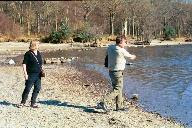Rainy morning, though if internet weather can be believed this should be the only rain of our stay. At breakfast J watches as a young girl at the buffet drops a piece of cake on the floor, goes to replace it on the plate, hesitates, and finally puts it on the counter next to the plate. From whence it is retrieved by a water and replaced on the plate. So the tongs placed beside the baskets of bread and plates of cake are incomplete guarantees of hygiene. And we remember in Cairo seeing a man with an enormous tray of bread drop a loaf on the road, pick it up and return it to the tray, and carry on with his deliveries. J has another of the "pancakes" - which we have discovered are not exactly pancakes. They're not made from batter but are white squares of a phyllo-like pastry unfolded by the girl and cooked briefly, one at a time, on a small griddle.
By noon it clears and we walk a bit in the opposite direction from the medina, past a walled cemetery and the Gendarmerie Royale. One forgets that this is a kingdom. Much less African looking here - with the standard international shops and a McDonald's. J, ever the economist, checks its prices. Difficult to knkow what to make of the Big Mac Index here, as a Big Mac is fifty percent more than a lamb tagine in the medina. So who would prefer it? The streets here show the French influence - broad avenues and enormous squares. some intersections have police but they leave pedestrians to their fate, operating in chatty pairs and only responding to the occasional motoring infraction. The lanes in the medina are reminiscent of Paris as well, but only in the pervasive smell of urine.
We are reading at night a book downloaded onto the Kobo, Edith Wharton's In Morocco, an account of a journey made to Morocco in 1917 - a trip made more difficult by German submarines in the Atlantic, the division of the country into Spanish and French zones, and the combination of early motorcars and primitive dirt roads. The author laments the lack of existence of a guide book, but she is well informed and has a good eye for detail and her work makes fascinating reading. Much of her description of Jamaa el Fna, the big square, still applies today, as she talks of the crowds surrounding dancers and snake charmers. A little earlier we had wondered if there had been an original purpose for the niches in the walls within the medina, cavities a little bigger than a person. The question of purpose remains unanswered, but Wharton does refer to "mad negroes standing stark naked in niches of the walls and pouring down Sudanese incantations upon the fascinated crowd." Shelter for the odd beggar today seems rather dull by comparison.
By noon it clears and we walk a bit in the opposite direction from the medina, past a walled cemetery and the Gendarmerie Royale. One forgets that this is a kingdom. Much less African looking here - with the standard international shops and a McDonald's. J, ever the economist, checks its prices. Difficult to knkow what to make of the Big Mac Index here, as a Big Mac is fifty percent more than a lamb tagine in the medina. So who would prefer it? The streets here show the French influence - broad avenues and enormous squares. some intersections have police but they leave pedestrians to their fate, operating in chatty pairs and only responding to the occasional motoring infraction. The lanes in the medina are reminiscent of Paris as well, but only in the pervasive smell of urine.
We are reading at night a book downloaded onto the Kobo, Edith Wharton's In Morocco, an account of a journey made to Morocco in 1917 - a trip made more difficult by German submarines in the Atlantic, the division of the country into Spanish and French zones, and the combination of early motorcars and primitive dirt roads. The author laments the lack of existence of a guide book, but she is well informed and has a good eye for detail and her work makes fascinating reading. Much of her description of Jamaa el Fna, the big square, still applies today, as she talks of the crowds surrounding dancers and snake charmers. A little earlier we had wondered if there had been an original purpose for the niches in the walls within the medina, cavities a little bigger than a person. The question of purpose remains unanswered, but Wharton does refer to "mad negroes standing stark naked in niches of the walls and pouring down Sudanese incantations upon the fascinated crowd." Shelter for the odd beggar today seems rather dull by comparison.




